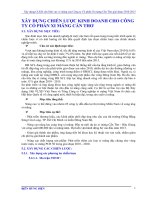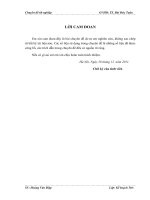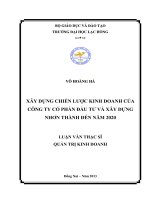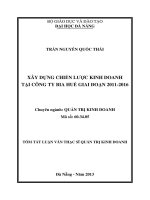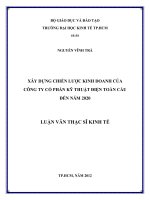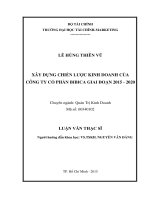Luận văn thạc sĩ xây dựng chiến lược kinh doanh của công ty cổ phần xi măng thăng long
Bạn đang xem bản rút gọn của tài liệu. Xem và tải ngay bản đầy đủ của tài liệu tại đây (450.08 KB, 61 trang )
Luận văn thạc sĩ Xây dựng chiến lược kinh
doanh của công ty cổ phần xi măng Thăng
Long
MAKE THE BUSINESS STRATEGY
FOR THE PERIOD OF 2011- 2015 OF
THANG LONG CEMENT JOINT STOCK
COMPANY
1
CONTENTS
Page
Acknowledgment…………………………………………………………………1
Contents…………………………………………………….……………………..2
List of tables………………………………………………………………………5
List of figures/ diagrams………………………………………………………….6
OVERVIEW………………………………………………………………………7
CHAPTER 1: ARGUMENT ………………………………..…………..8
1.1. Argument about business strategy for the enterprise …………………..8
1.1.1. Some definitions about strategy ………………………………….………8
1.1.2 Nature of the business strategy…………………………………..………. 9
1.1.3 Characteristics of business strategy …………………………..…………10
1.2. Process of making strategy………………………………………………. 10
1.3. Model – analysis of the external environment ……………………………11
1.3.1. Model – macroscopic analysis (PESTLE model)…………..………….11
1.3.2. Model of 5 forces of Michael – sector analyis …………..…………….12
1.4. Model of internal analysis of the enterprise……………………..……….13
1.4.1. Value chain………………………………………..…...………………..13
1.4.2 Internal Factor Matrix- IFE………………………..…..…………………….13
1.4.3. External Factor Matrix- EFE…………………….…………………………14
1.4.4. Total IFE point…………………………………………………………………14
1.4.5 Matrix of strategic space of the enterprise …………………………………14
1.4.6. Sustainable competitiveness advantage of the enterprise …………….14
1.5. Model of general analysis (SWOT)………………………….…………..14
1.6. General competitiveness strategies……………………………..……….15
1.6.1. Cost Leadership strategy ……………………………………………15
2
1.6.2. Differentiation Strategy …………………………………………..…15
1.6.3. Focus strategies …………………………………………..………….15
1.7. Model of analyzing and selecting strategy under weight method………... 16
CHAPTER 2: ANALYSIS OF REAL SITUATION OF THANG LONG
CEMENT JOINT STOCK COMPANY …………………………………….18
2.1. Overview of Thang Long Cement Joint Stock Company ……………..18
2.1.1. Process of establishment and development…………………………………..18
2.1.2. The fields of business production activities of the company………………18
2.1.3. The structure of management machine of the company……………………19
2.1.4. Results of business production in 2008 – 2010: …………………………….19
2.2. Analysis of external environment of Thang Long Cement Joint Stock
Company ………………………………………………………….……..……..22
2.2.1. Analysis of macroscopic environment (PESTLE model)…………………...22
2.2.2. Analysis of the environment of cement sector (model of 5 forces): ………23
2.3. Analysis of the internal environment of Thang Long Cement Joint Stock
Company ………………………………………………………………….…..29
2.3.1. Model of value chain……………………………………………………………29
2.3.2. Internal Factor Matrix- IFE of Thang Long Cement Joint Stock Company. 33
2.3.3 External Factor Matrix- EFE of Thang Long Cement Joint Stock Company.
34
2.3.4 Total IFE point of Thang Long Cement Joint Stock Company ………….…35
2.3.5 IE Matric…………………………………………………………………………….35
2.3.6 Matrix of strategic space of Thang Long Cement Joint Stock Company ….36
2.3.7. Sustainable competitiveness advantage …………………………………..37
2.4. Total SWOT matrix of Thang Long Cement Joint Stock Company ….40
2.5. Limitations, existing reasons in Business strategy ………………………..41
2.5.1 Limitations………………………………………………………………………….41
2.5.2 Reasons………………………………………………………………………………42
CHAPTER 3: SOLUTIONS, SUGGESTIONS AND CONCLUSION…….. 43
3
3.1. Business strategy of the company in the period of 2011 – 2015 ………….43
3.1.1. Vision………………………………………………………………………………...43
3.1.2. Mission……………………………………………………………………………..43
3.1.3 Targets for the period of 2011 – 2015 …………………………………………..43
3.1.4. Selection of business strategy for Thang Long Cement Joint Stock Company
for the period of 2011 – 2015 ……………………………………………………..……44
3.2 Some solutions to implement successfully the selected strategy …..……..52
3.2.1 Change of the financial management method of the company ……….………52
3.2.2. Re-developing the Marketing activity, in which respecting the system of
distribution channel; activity of customer services……………………………..…….54
3.2.3. Establishing the Research and Development Department……………………57
3.2.4. Applying the operation method of the Factory under international regulation
for a modern cement factory…………………………………………………………….57
3.2.5. Development of human resource ………………………………………..………58
3.3. Roadmap of implementation of business strategy of Thang Long Cement
Joint Stock Company in the period of 2011- 2015 …………………………..59
3.4. Supervision of implementation of business strategy in the period of 20112015 ……………………………………………………………………..………59
CONCLUSION…………………………………………………………..…….61
REFERENCE………………………………………………………….…………62
4
LIST OF TABLES
Page
TABLE 2-1: Business achievements in the period of 2008- 2010…………….…..19
TABLE 2-2: Summation table of the internal factors of Thang Long Cement in
comparison with competitors ………………………………………………..……33
TABLE 2-3: Summation table of the external factors of Thang Long Cement in
comparison with competitors ……………………………………………….……..34
TABLE 2-4: Summation table of the internal - external factors of Thang Long
Cement in comparison with competitors ……………………………….…………35
TABLE 2-5: IE Matric……………………………………………………………..35
TABLE 2-6: Summation table of formation factors of SPACE matrix of Thang
Long Cement ………………………………………………………….…………..36
TABLE 2-7 Total competitiveness image of Thang Long Cement Joint Stock
Company ……………………………………………………………….………….40
TABLE 3-1: Targets of Thang Long Cement ……………………………………..43
TABLE 3-2 SWOT matrix of Thang Long Cement Joint Stock Company ….…….44
TABLE 3- 3 Select suitable strategy under weight method ……………………….50
TABLE 3-4: Summation table of strategy selection ………………………………51
Table 3-5: Summation table of cost and labor productivity in year 2010……….....51
TABLE 3-6: Roadmap of increasing the chartered capital……………………….53
TABLE 3-7: Level of support for sales in rainy season……………………….…..56
5
LIST OF FIGURES/ DIAGRAMS
Page
Figure 1-1 Model of the process of strategic management…………………...……11
Figure 1-2 Diagram of structure of sector competitiveness ………………………12
Figure 2-1: Diagram of organization………………………………………………19
Figure 2-2: Revenue structure of Thang Long Cement under products ……..……20
Figure 2-3: Market structure of Thang Long Cement in Vietnam…………………21
Figure 2-4: Market share of Thang Long Cement in the period of 2008 – 2010…. 21
Figure 2-5: Situation of cement consumption in the period of 2008 – 2010 and the
forecast for 2015 ………………………………………………………….………24
Figure 2-6: Process of cement production………………………………..……….30
Figure 2- 7 Value chain relating to the operation of Thang Long Cement Joint Stock
Company ……………………………………………………………….…………32
Figure 2- 8g: SPACE matrix of Thang Long Cement ……………………………37
6
OVERVIEW
Vietnam’s economy has had the growth of 6,78% in 2010 and forecasted to
continue the higher growth in coming years; and the construction sector will have
the growth level twice in comparison with that of GDP. However, it is different
when considering in each sector, the demand for construction materials is increased,
but according to the forecast of Ministry of Construction, from 2011, the supply of
cement could be redundant over 10 million tons and higher than in next years when
many factories will come into operation.
Thang Long Cement Joint Stock Company was established in 2001, passed
by the construction process, in 2008, the factory came into operation. For the
challenges of the cement redundancy as the forecast, making a long-term business
strategy is the most important. Therefore, our group selects the topic “Developing
the business strategy for the period of 2011 – 2015 of Thang Long Cement
Joint Stock Company”.
Research purpose is to make the suitable business strategy for Thang Long
cement so that the Company could have the sustainable development. With building
a comprehensive and feasible strategy, it will be submitted for General Assembly of
the Shareholders which will have the meeting held dated April 1 st 2011 for the
approval.
Implementation method: approach the learned theories about strategic
management; survey to collect the data in Thang Long Cement Joint Stock
Company and gather, summarize the data from State management bodies,
websites…
Structure of the Assignment includes 03 chapters: Chapter 1 – Argument
foundation; Chapter 2 – Analysis of real situation of Thang Long Cement Joint
Stock Company; Chapter 3 – Solutions, suggestions and conclusion
7
Because of the limited time, collection and analysis of the data are restricted.
Writers’ group would like to receive the contribution opinions of the teachers,
students and the people who are interested in the cement sector so that the topic will
be better.
8
CHAPTER 1: ARGUMENT FOUNDATION
1.1. Argument of business strategy for the enterprise
1.1.1. Some definitions about the strategy
According to normal definition, strategy is a military term used to show the
plan of disposing the troops in battle formation and distribution of the force with the
target of winning the enemy or reaching its military target. Carl von Clausewitz –
the artist of the war of the 19th century – described the strategy as “making the plan
of war and making the operation campaigns. Those campaigns will decide the
participation of each individual”. Historian Edward Mead Earle described the
strategy as “the art of supervision and using the resource of a country or an
alliance of the countries, aiming at ensuring and increasing the effectiveness for its
essential rights”
Nowadyas, definition of strategy is used popularly and considered as the
foundation for the operation of the business enterprise. There are many definitions
of the strategy such as Strategy is the model of targets, destinations and plans to
reach those targets (Kenneth, 1965. Strategy is the plan of controlling and using
the resource of the organization like as human resource, assets, finance...aiming at
improving and ensuring its essential rights. Kenneth Andrews is the 1st person to
make the outstanding ideas in the classic book The Concept of Corporrate Strategy.
According to him, strategy is what an organization must implement basing on its
strengths and weaknesses in the context including the opportunities and even
threats.
1.1.2 Nature of business strategy
- Business strategy of the enterprise is the business method of the enterprise, in
terms of Business strategy, it is the operation rule of the enterprise; method of using
the resources; foundation to solve every problem of the enterprise.
- Business strategy is the expression of the concept of the enterprise’s value,
improvement spirit, strong willing of the enterprise’s leader, reflecting evaluation of
the leader about the objective situation, subjective condition of the enterprise.
9
1.1.3 Characteristics of business strategy
Comprehensiveness: Comprehensiveness of Business strategy requires considering
all parts of the enterprise, analyzing the situation of the whole enterprise, the
situation of the whole country and of the world.
Visionariness: A success strategy often is a strategy basing on exact forecast.
Competitiveness: Business strategy must do research on how the enterprise has the
competitiveness advantage rather than the competitors and thus reaching the victory
in the competition.
Threats: Threats of Business strategy require the enterprise to stand highly, be
visionary, and observe carefully, objectively to have the right strategy
Professionalism and creativity: Suitable specialization and technical creativity are
the important methods to ensure the existence and development of the enterprise.
That is also the important characteristic in Business strategy of the small and
medium enterprise.
Relative stability: Business strategy of the enterprise must have relative stability in
a certain period
1.2. Process of making the strategy
In order to make the strategy, it requires having strategic thinking and
answering 03 questions “Now where are we? Where do we need to go to? And how
do we come there?” through 7 steps
1. Current evaluation: Mission, targets, strategies.
2. Analysis of business environment: Market structure, development situation,
analysis of competition and position of the enterprise
3. Analysis of macroscopic environment: environment of demography, economy,
society, technology and politics
4. Internal analysis of the enterprise: structure, resources, process, human resource
and enterprise culture
5. Analyze strengths, weaknesses, opportunities and challenges (SWOT)
6. Analyze and select the strategy: share or according to the sector
10
7. Evaluate and implement: requirement of resource, threats and benefits.
Process of strategic management include: With process of strategic management
which is described as in Figure 1-1 below
Mission, vision
Internal analysis
+ Model:
- Value chain,
- Competitiveness
advantage
+ Taken conclusion:
- Strengths
- Weaknesses
Make and select
strategy
(SWOT)
External analysis
+ Macroscopic
analysis: external
environment
+ Microscopic: model of
5 competitive forces
Selected strategy
Cost Leadership
Differentiation
Focus
Make
organization of
the machine to be
suitable with
strategy
Implementation and
adjustment of strategy
Supervise and
evaluate strategy
implementation
Figure 1-1 Model of the process of strategic management
Source: Document of the lecture of strategic management
1.3. Model – analysis of external environment
1.3. 1. Model – macroscopic analysis (PESTLE model)
Factors of macroscopic environment are expressed through following model
- Analyze the environment of demography:
- Analyze the environment of politics and law:
- Analyze the environment of economy:
- Analyze the environment of technical science and technology
- Analyze the environment of social culture
11
- Global environment
Macroscopic analysis allows the enterprise to evaluate the macro-economic
factors which have strong influence on the activities of the enterprise and basic
changes in competitive environment. Macroscopic analysis can be illustrated as
followed:
1.3.2. Model of five forces of Michael (Five force )1- Sector analysis
Model of analyzing 5 forces of Michael Porter, helping strategists to analyze
the above forces – completive structure of the sector, is summarized in the followed
diagram:
Threats of potential competitors
Negotiation
capacity of
supplier
Competition of
existing
companies
Negotiation
capacity of buyer
Threats of
substitution
products
Figure 1-2 Diagram of structure of sector competition
Source: Michael E. Porter- 1980
- Threats of potential competitors: the enterprise which has newly participated in
the market could be an enterprise that has just been established or an enterprise
that did business on other products in the past, now does business on many
products.
1
See Michael E. Porter- Harvard University - 1980
12
- Threats of substitution products: substitution products are the products with the
similar use. If the benefit of substitution products is big, the pressure of the
competition is large (pressure of the price) and making the enterprise to fall into
the defensive. If the producer which produces the substitution products quickly
develops production, that sector will be influenced strongly.
- Negotiation capacity of the buyer: customers of the enterprise could be the
direct consumers for the consumed goods, when the consumers require the price
to be cheaper, the quality of the goods to be better, and the service of after-sales
to be better; they are also the pressure for the sector. But the customers are also
the distributors or agents.
- Competition of existing companies: Competition among the enterprises in the same
sector is expressed through the form and characteristic of the competition.
- Negotiation capacity of the supplier: suppliers of materials have the capacity to
increase the price or lower the quality of the products or both increase the price and
lower the quality of the products.
Analysis of real situation, tendency, collection intensity of 5 above forces decides the
severe level of the competition, ability of reaching the victory of the enterprise and
scale, characteristic of the enterprise in that sector.
1.4. Model of internal analyis of the enterprise
1.4.1. Value chain
Value of an enterprise is measured by the quantity which the buyer is ready
to pay for the product or service. The enterprise has the profit if the created value is
larger than the cost.
Michel Porter, originated from analysis “each company is the collection of
activities to implement, aiming at designing, producing, selling, delivering and
supporting for the products”. Each operation increases the value of the product.
“Value chain” is divided into main activities and support activities.
1.4.2 Internal Factor Matrix- IFE
13
Using this matrix in analyzing the internal factors of the enterprise in
comparing with the competitors. From calculating the score of the company,
analyzing and defining the position in comparison with the competitors by the
internal force.
1.4.3. External Factor Matrix- EFE
Using this matrix in analyzing the external factors of the enterprise in
comparing with the competitors. From calculating the score of the company,
analyzing and defining the position in comparison with the competitors from the
influence of external factors.
1.4.4. Total IFE point.
Summation from analysis of internal – external factors
1.4.5 Matrix of strategic space of the enterprise (Space matrix)
From calculating about financial potential, strengths of the sector,
competitive advantage and stability of environment to make score of defining the
position of the enterprise
1.4.6. Sustainable competitiveness advantage of the enterprise
Sustainable
competitiveness
advantage
of
the
enterprise
has
04
characteristics:
Firstly, it has the value, possible to help the enterprise to create the value,
reduce the price, improve the business effectiveness. Secondly, it is original,
combining with the resource by an original method. Thirdly, it is endogenous; its
generation is the result of mutual influence among units, individuals in the
organization, through combination and organization of technical resources of the
enterprise. Fourthly, competitive advantage of the enterprise is formed in the
process of learning, accumulating of the enterprise, which is impossible to be
bought in the market, other people are difficult to imitate.
1.5. Model of general analysis (SWOT)
SWOT analysis: Strengths, Weakness, Opportunities and Threats. SWOT
analysis is the key of strategic development, making clearly the internal strengths of
14
the organization; Weaknesses and opportunities, threats from the external
environment.
SWOT model is used to analyze the strengths, weaknesses, opportunities and
challenges of an enterprise to define suitable Business strategy. This business
strategy will promote the strengths of the enterprise; resolve the weaknesses in
taking advantages of the business opportunities and overcoming the challenges of
external environment.
1.6. General competition strategies
1.6.1. Cost Leadership Strategy
Is strategy to produce the goods or services with lower cost than the
competitors. This strategy has 02 basic advantages: Firstly, with lower cost, leader of
the cost can make the lower price than competitors but still collect the profit same to
the competitors. If the enterprises in a sector reach the similar values for their products,
leader of the cost can collect the higher profit because it has the lower cost; secondly, if
the competition in the sector is increased and the enterprises compete with each other
by the price, leader of the cost has the ability to stand more firmly in the competition
than other enterprises because of its lower cost.
1.6.2. Differentiaton Strategy
Purpose of strategy of the distinction of the products is to reach the competitive
advantage by creating the products, goods or services which are recognized by the
consumers to be the most original. The capacity of an enterprise with the distinction
of the products to satisfy the demand of the consumers under the way which the
competitors are impossible to have, it means it could set up the remarkable higher
price than average level of the sector. The capacity of increasing the revenue by
reaching higher price (but not by reducing the cost like as the leader of the cost)
allows the enterprise with the distinction of the products to operate better than its
competitors and receive higher profit.
1.6.3. Focus strategies
15
Concentrative strategy is different from 02 above strategies mainly because it is
oriented to serve the demand of a limited group of the consumers or market segment.
The enterprise which pursues the concentrative strategy focuses on serving a specific
market segment, that segment can be defined basing on the criteria of geography, type
of the customers or a branch of product line through distinction of the products or low
cost. Nature of concentrative enterprise is an enterprise with the distinction of the
products or the leader of the cost
1.7. Model of analyzing and selecting the strategy under weight
method
Weight method selects a strategy in a series of the made methods basing on
evaluating the selection criteria such as value of the enterprise, revenue, profits,
investment level, competitive advantage, suitability level with current culture of the
enterprise, time… to look for the best strategy in made strategies. This method
includes 04 below steps:
Step 1: Select some most important, suitable criteria with the characteristic of the
enterprise to evaluate the competitive strategies such as value of the enterprise,
revenue, profit, threats level, investment level, competitive advantage…This is
subjective step of the selector.
Step 2: Add the weight to the criteria to define the importance of the criteria which
have the bigger influence on the final decision
Step 3: Make score for each strategic method under each criterion
Step 4: Calculate total product to define which strategic method has the highest
score that will be the selected method
All in all, Chapter 1 makes clearly argument method to design Business
strategy. Firstly, introducing the concepts, nature, characteristics of Business
strategy; secondly, introducing the models of analysis of internal and external
environment of the enterprise including: model of analysis of external environment,
model of 5 forces, model of value chain, analysis of sustainable competitive
advantage and summation model – SWOT; thirdly, analyzing basic competitive
16
strategies and selecting Business strategy under weight method. Moreover, in the
analysis part, writers’ group will also use the tools of Marketing theory.
17
CHAPTER 2: ANALYSIS OF REAL SITUATION OF THANG LONG
CEMENT JOINT STOCK COMPANY
2.1. Overview of Thang Long Cement Joint Stock Company
- Established on May 28th 2001, certificate of business registration No. 2203000011
issued by Division of Business Registration – Department of Planning and
Investment of Quang Ninh province
- Factory and office are located in Le Loi commune, Hanh Bo district, Quang Ninh
province; grilling station is located in Hiep Phuoc industrial area – Nha Be – Ho
Chi Minh City
- President of Executive Board: Mr. Tien, Vu Van
- General Director: Mr. Do, Le
- Established by shareholders: Hanoi General Export Import Joint Stock Company
(GELEXIMCO), Vietnam Machine Installment Corporation (Lilama) and some
natural persons.
- Chartered capital at December 31st 2010: 1,500 billion VND
- This is the first private Company which produces the cement and is guaranteed by
the Government to borrow foreign capital.
Slogan: Foundation of the success
2.1.1. Process of formation and development:
- 2001: Establish the Company;
- 2002: Prime Minister approves the investment into Thang Long Cement Factory
under Decision No.627/QĐ-TTg dated July 29th 2002 of Prime Minister investing
into the project of Thang Long Cement Factory;
- 2005: Start building;
- 2008: Complete the Factory and go into operation
2.1.2. Fields of business production activities of the company:
Production and doing business on cement with main products: Separate cement/
packed cement PC 40, PCB40; Clinker (semifinished product).
18
2.1.3. Structure of management machine of the company
GENERAL ASSEMBLY OF
SHAREHOLDERS
BOARD OF
CONTROLLING
EXECUTIVE BOARD
BOARD OF GENERAL
DIRECTOR
Secretary/Assistant
PRODUC
TION
BUSINES
S
FINANCE
ADMINISTR
ATION
PROJE
CT
REPRESENTAT
IVE OFFICE OF
THE CENTRAL
HCMC
BRANC
H
Figure 2-1: Diagram of organization
Source: Administration area of the Company
Total personnel of the whole company at December 31 st 2010 is 709, in
which main factory in Quang Ninh and Hanoi office are 619 people, office in the
Central is 09 people, HCMC branch is 81 people. About knowledge degree, there is
01 doctor, 05 masters, 239 graduated people, and the left are graduated from the
Colleges, secondary schools, technical workers. The structure of labor age is 20 –
25 years old for the most: 42%; then 25 – 30 years old: 36%, 30 – 35 years old:
13%.
2.1.4. Achievements of business production in the period of 2008- 2010:
TABLE 2-1: Achievements of the business in the period of 2008- 2010
No.
1
2
Target
Capacity
Revenue
Unit
2008
%
Billion
2009
60
749
19
83
1,216
2010
88
1,352
VND
3
Profit
billion
VND
4
Total asset
billion
VND
5
ROA
%
6
ROE
%
Source: Financial area of the Company
-234
-323
-578
4,954
5,627
6,037
-5
-175
-6
-289
-4
-579
From table 2-1, it shows the business results of the Company are not good
because the Factory has just gone into operation, having to pay for the cost from the
investment period. According to calculation, from 2011 and later, the factory will
not be at a loss and from 2012, the Company will collect the profit and 2017 will be
the time to take back the invested capital. The operation capacity of the factory in
2010 is 88%, evaluated as the success about operating the factory; the product has
reached the relevant quality with the cement factories operating for a long time
According to the financial analysis, accumulated profit of the factory is
around 30% of revenue, the post-tax profit is negative because the financial cost is
influenced strongly by interest rate and exchange rate due to loan of foreign
currency from foreign bank, adding to high cost for sales because the factory must
pay for marketing, establishing distribution channel in first years.
Figure 2-2: Revenue structure of Thang Long Cement under products
20
Source: Collection of writers’ group
From Figure 2-2: shows the main income of sales of Thang Long cement is
from cement, Clinker is fluctuated around 30%. This is the income resource with
stable structure within 03 last years.
About the market, Thang Long cement is expressed as follows:
Figure 2-3: Market structure of Thang Long cement in Vietnam
Source: Calculation and collection of writers’ group
From figure 2-3, it shows, the market of Thang Long cement in Vietnam is
still concentrated in the North, however market share was partly decreased in 2009,
2010 because of gradual increase of market share in the Central, the South.
In order to have the overall picture about business results in the period of
2008 – 2010, writers’ group collected, summarized the data about the market share
of Thang Long cement in comparison with Vietnam Cement Corporation (Vicem),
joint venture cement companies, joint stock cement companoes and separated
market share of Thang Long cement.
21
Figure 2-4: Market share of Thang Long cement in the period of 2008 –
2010
Source: Calculation and collection of writers’ group
Through figure 2-3, it shows market share of Thang Long cement was
increased gradually through years from 2, 5% in 2008 to 3, and 7% in 2010, making
up high rate is still Vietnam cement corporation (Vicem) where there are many
member factories
2.2. Analysis of external environment of Thang Long Cement Joint Stock
Company
2.2.1. Analysis of macroscopic environment (PESTLE model)
2.2.1.1. Economic environment: Forecast in the plan of socio-economic
development in 5 years of 2011- 2015 approved by Vietnam’s Government, annual
GDP growth is over 7%, this shows an economy will develop strongly in the future.
In order to reach this, the contribution of construction sector is very big, cement
industries also open a lot opportunities in joint targets of construction sector.
Urbanization rate is quick, forecasted from 2011- 2015, Vietnam’s urbanization rate
is around 30-35%, together with developing and completing the infrastructure.
Demand of the cement for economic development is very large, from serving for
civil construction, industrial construction, and transportation.
2.2.1.2 Environment of politics, law: stability of politics is the 1 st decisive
factor for the development of Vietnam’s cement. System of related documents to
the sector of construction, transportation issued by Vietnam’s National Assembly:
Construction law; Housing law; Law of Business on Real estates; Law of road
transport…creating legal corridor for these sectors. On May 16 th 2005, Prime
Minister issued Decision No.108/2005/QĐ-TTg about approving Planning for
exploring, exploitation and using the mineral for cement in Vietnam to 2020.
2.2.1.3 Environment of demography: According to the data of General
Department of Statistics, in 2010, Vietnam’s population is 87 million people,
forecasted in 2011, population is over 88 million people; evaluated to be young
22
population, the demand for the housing every year is still high, then the demand for
construction. When there is the growth of construction, leading to the demand of
construction materials, including cement. This is also the best opportunity for
Vietnam’s cement now.
2.2.1.4. Environment of technology: In the world now, modern technology of
cement production has been applied widely for reverter furnace cement; there are 2
technological centers for producing the cement including Japan and Europe.
Currently, Vietnam has also been applying 02 these technologies into producing
cement. The factories are built under joint venture form, mainly Japan’s technology;
and other factories mainly import the equipments from Europe, from countries:
France, German, Switzerland… Technology of Thang Long cement factory is from
Polysius Group – Republic of German.
2.2.1.5 Global environment: development of construction sector in the world
is in the boom period. The demand for the cement is very large, current
concentrating on the market of Arab, Africa. This is also good opportunity for
Vietnam’s cement factories participating in the import. In 2009, Cam Pha cement
exported to Africa with 20.000 tons. At the beginning of 2011, Thang Long Cement
exported to Africa with 25.000 tons for the export plan of 50.000 tons.
2.2.1.5 Environment of social culture: In construction, besides the materials
to make the project to be firm such as iron, steel, stone, sand, cement is the
indispensable factor. It could be said that when mentioning the construction
material, it means the cement.
2.2.2. Analysis of environment of cement sector (model of 5 forces):
2.2.2.1 Internal competition of the sector: internal competition of the sector
is happening strongly; total the cement factories which have been operating and
licensed are 61 factories including: Vietnam’s Cement Corporation and 7 member
companies, 48 Cement companies of mixed ownership, 05 joint venture cement
companies. Cement factories which have been operating for a long time are Hoang
Thach Cement, Bim Son Cement, But Son Cement, Ha Tien Cement.
23
Unit: million tons
Figure 2-5: Situation of cement consumption in the period of 2008 – 2010 and
forecast to 2015
Source: Ministry of Construction - Vietnam
From Figure 2-5, it shows the supply and demand of the market from 2010
and earlier were less strained, but from 2011 and later the situation is different,
estimated that the supply will be far from the demand, over 20 million tons/ year,
this shows the strong competition happening in the cement sector.
In 2010, Vietnam had 11 cement projects invested newly or expanded for
operation with the more increased supply resource by 10 million tons/year;
forecasted to be similar in next years. Therefore, annual cement cupply resource is
increased by over 20%. While the demand for the cement has the slower growth by
20%, leading to the cement redundancy. The warning of the cement redundancy
was made from the 2007s, but the localities followed the achievement, breaking the
planning in the cement sector, approving the excessive investment. This is also the
general consequence of Vietnam’s cement industries when the local benefit is still
heavy in economic development.
24
Besides that, shortage and redundancy also happen in Vietnam’s provinces.
In the North, redundancy is for both Clinker and cement because there are so many
cement factories concentarted here, including provinces: Quang Ninh, Hai Phong,
Ha Nam, Ninh Binh; while in the Central provinces, it is lack of cement, balance
with clinker; in the South, it is lack of clinker, redundancy of cement. The
consumption rate of the cement in the North is 50%, the Central is 18%, the South
is 32%.
In next time, Vietnam’s cement could have to compete with the importd
cement because of opening the door under WTO’s commitment when the price of
imported cement is cheaper than the price of cement produced in Vietnam.
Enterprises in the cement sector compete with each other mainly about the
price because the quality of the cement could be similar, the distinction of the
cement is not clear. In order to compete, the enterprises must lower the production
price, implement the policies for preference, after-sales, customer service. This
competition happens among the enterprises of Vietnam’s Cement Corporation and
other private cement enterprises; between domestic enterprises and foreign invested
cement production enterprises. However, competitive advantage is still for the
enterprises directly under Vietnam’s Cement Corporation with over 40% of
production factories and 30% market share because they are near material resource,
the machines, equipments came to an end of depreciation period, but they meet the
challenge that is backward equipment technology and mostly originated from
China, thus the production price is high, loss in production process is much.
Advantage of the cement production enterprises with private ownership is because
of new investment, modern technology, low production price and equal quality to
the cement of Vietnam’s Cement Corporation.
2.2.2.2 Power of the supplier: strongly affect because of the input price
including coal, electricity, and limestone;
The input materials of cement production are limestone, coal, electricity and
additive. In which, supply of limestone, coal, electricity has influence on the
25
